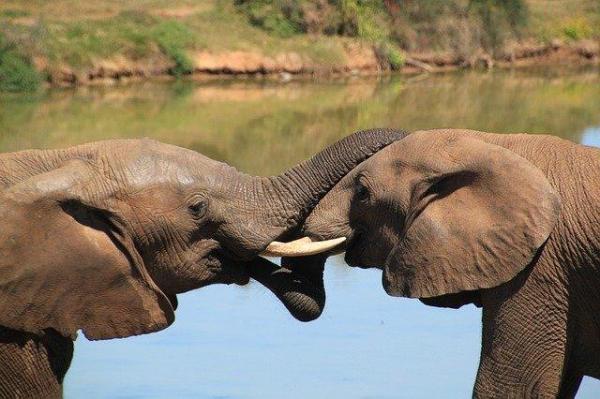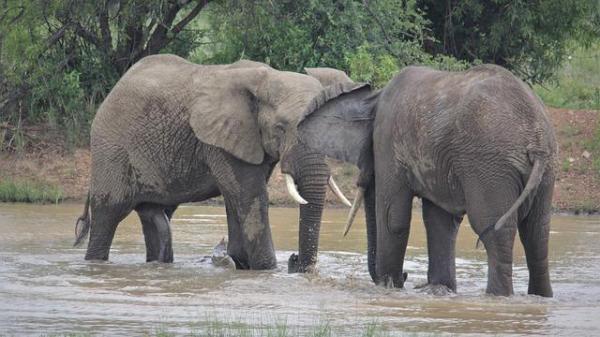
The elephant is one of the largest and most intelligent animals on our planet. They are known for their extraordinary memory, empathy, and sophisticated social structures. One of the most fascinating aspects of their behavior is their communication skills. Elephants have a remarkable ability to communicate complex messages and emotions to each other in a variety of ways. Their communication system is vital to their survival and helps them maintain social bonds, find food and water, and navigate their environment.
This AnimalWised article explains how elephants communicate and shares other fascinating elephant facts.
Elephant communication
Elephant communication is a complex and fascinating topic that has been studied extensively by researchers. They communicate for a variety of reasons, including maintaining social bonds, coordinating group activities, finding food and water, and avoiding danger. Most animals communicate with each other to a greater or lesser extent, and the more social a species is, the more communicative it tends to be.
Elephants are highly social animals that live in family groups called herds. Communication is essential for maintaining social bonds and relationships within these herds. Elephants use a variety of vocalizations, body language, and chemical signals to greet each other, show affection, and maintain their social hierarchy.
In addition to social communication, elephants also use communication to coordinate group activities, such as foraging or traveling. Group coordination is critical to the survival and success of elephant groups. It helps them find food and water, protect each other from predators, care for their young, among others.
Effective communication is also critical for elephants to avoid danger. As large and herbivorous animals, elephants face threats from predators such as lions and hyenas and must communicate and coordinate to protect themselves. Elephants often work together to warn each other of danger and coordinate defensive tactics.
Furthermore, elephant communication is not limited to their own species. They have been known to communicate with other animals, such as birds and primates, to warn them of potential danger. Their communication skills have also been observed in their interactions with humans, as they can understand and respond to human commands.
You may also be interested in this other article, where we talk about how elephants sleep.

How do elephants communicate?
Notably, elephants can communicate over both short and long distances, allowing them to stay connected even when physically apart. Elephants employ diverse communication techniques to interact with each other, such as vocalizations, gestures, and chemical cues. Here, we will delve deeper into the different communication methods utilized by elephants.
Sounds
Elephants make a wide range of sounds, including trumpets, rumbles, snorts, grunts, and growls. These sounds can be used to convey a variety of messages, such as greetings, warnings, or expressions of excitement or distress. The trumpet is perhaps the best known sound elephants make. It is a loud, high-pitched call that can be heard from a distance.
Body language
Elephants use their trunks, ears, tails, and posture to communicate information to each other. They may wiggle their ears to show excitement or aggression, or wave their trunks to greet or warn other elephants. They may also adopt different postures to signal their intentions or emotions, such as standing upright to appear threatening or bowing to show submission.
Chemical signals
Elephants use pheromones, chemical signals released by one individual and sensed by another, to communicate over long distances. Pheromones can convey information about an individual's age, sex, reproductive status, and emotional state. Elephants can pick up these signals with their sensitive trunks and use them to locate other elephants or avoid potentially dangerous situations.
Vibrations
Previous studies have shown that it is possible for elephants to monitor vibrations in the ground through their bodies, a characteristic more commonly associated with small creatures such as scorpions and insects. Vibrations on the ground can be used to warn each other of danger and to find mates during their all-too-short breeding season. For elephants to find each other, they need to be able to announce their fertility, somehow. For example, elephants have been observed to flee to higher ground prior to the arrival of distant tsunamis, and that a mother elephant that feels threatened will stomp on the ground to warn others.

Differences in communication between male and female elephants
Male and female elephants exhibit different social behaviors, and communication serves different purposes in the two sexes.
Female elephants form the core of the social unit, with the mother and her offspring as the basic unit. These groups can span multiple generations and use active communication to strengthen family bonds, provide security for offspring, resolve conflicts within the group, unite against threats, and maintain contact over long distances. In essence, communication between females helps maintain herd cohesion.
In contrast, male elephants have a more dynamic social life. While females generally remain in the same herd throughout their lives, males may leave their natal group at age 10 and join an all-male group or even live a solitary life. Consequently, communication among males focuses primarily on assessing the presence and dominance of other elephants in the vicinity, establishing a hierarchy, and identifying potential mating partners.
In summary, male and female elephants inhabit two distinct social worlds, and their communication strategies reflect their different lifestyles.
Can elephants communicate with humans?
Indeed, elephants possess the ability to communicate with humans to a certain extent. They exhibit high levels of intelligence and can learn to recognize and react to verbal and non-verbal cues provided by humans.
In various settings like circuses and zoos, elephants have been trained to carry out diverse tasks, including obeying commands. Research also suggests that elephants may have the capacity to comprehend and react to human language in more sophisticated ways. Nonetheless, it is vital to exercise caution and show respect when interacting with elephants, as they are still wild animals.
You may be interested in this other article, where we explain how to escape an elephant attack.
If you want to read similar articles to How Do Elephants Communicate?, we recommend you visit our Facts about the animal kingdom category.
- Connor, T. 2009. " Loxodonta cyclotis ". Animal Diversity Web. University of Michigan, Museum of Zoology. Available at: https://animaldiversity.org/accounts/Loxodonta_cyclotis/
- Howard, M. 2017. " Loxodonta africana ". Animal Diversity Web. University of Michigan, Museum of Zoology. Available at: https://animaldiversity.org/accounts/Loxodonta_africana/
- Mortimer, B., Lake, W., Koelemeijer, P., & Nissen-Meyer, T. (2018). "Classifying elephant behavior through seismic vibrations". Current Biology 28, R527–R548. Available at: https://www.cell.com/action/showPdf?pii=S0960-9822%2818%2930420-2